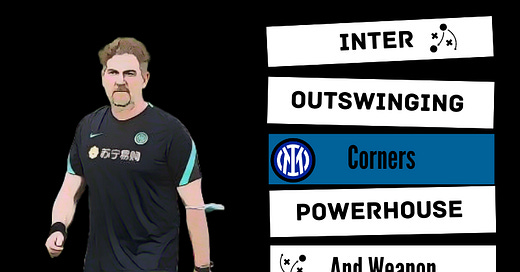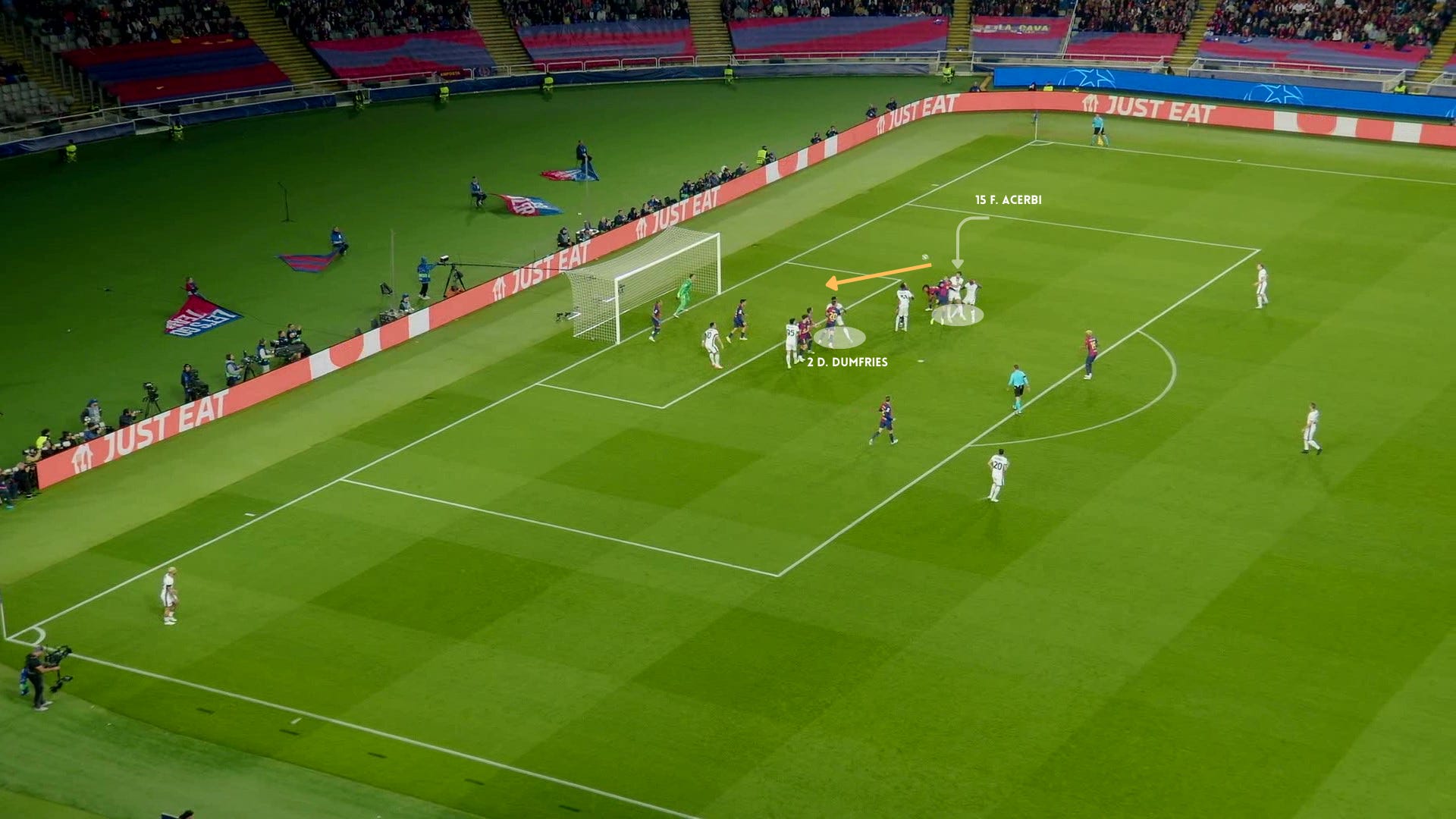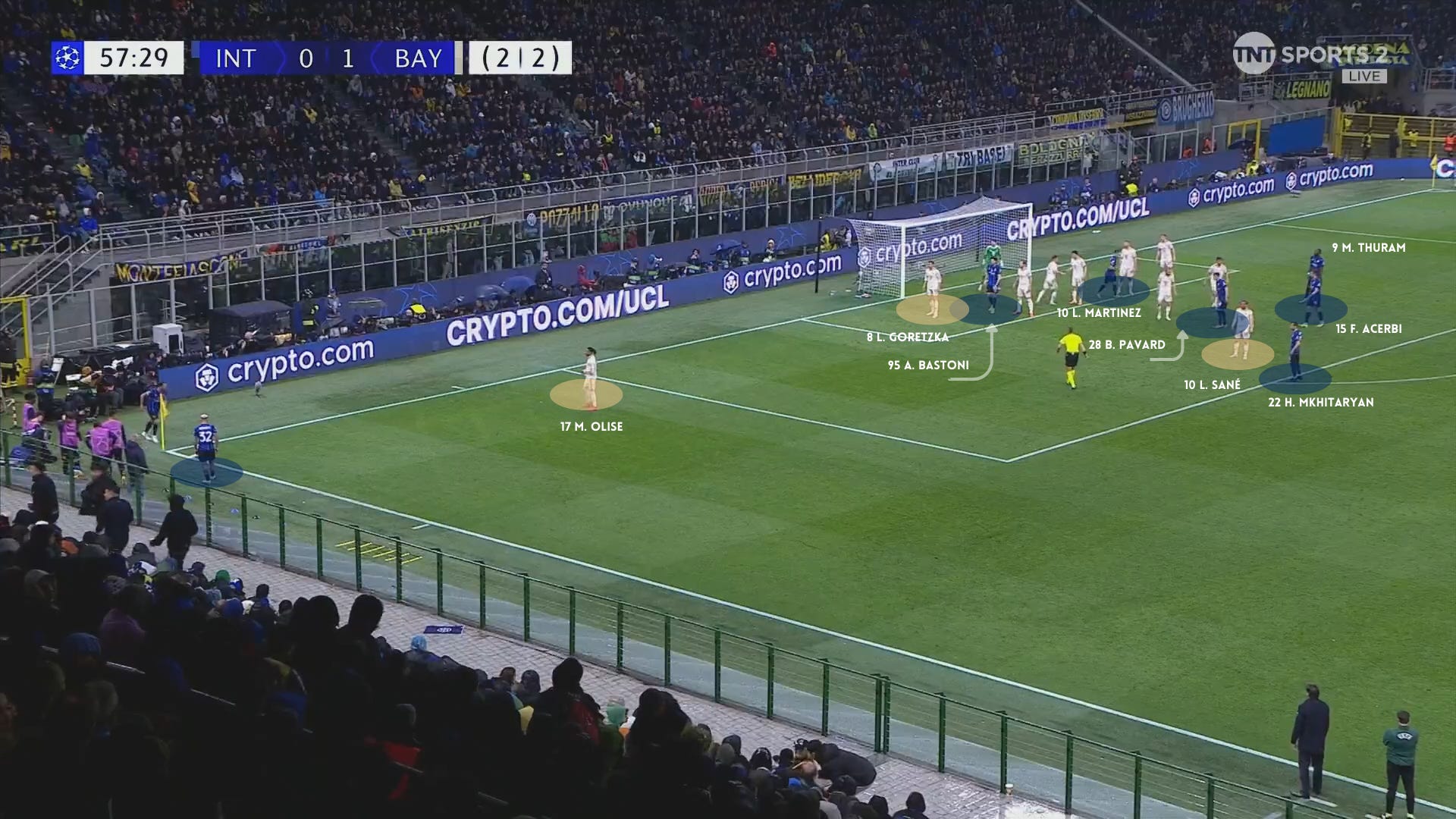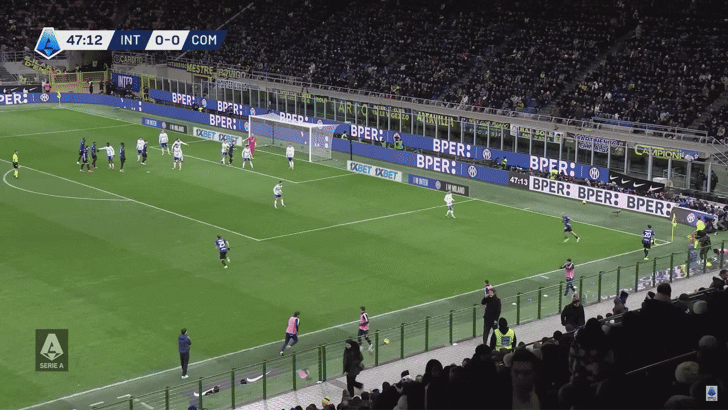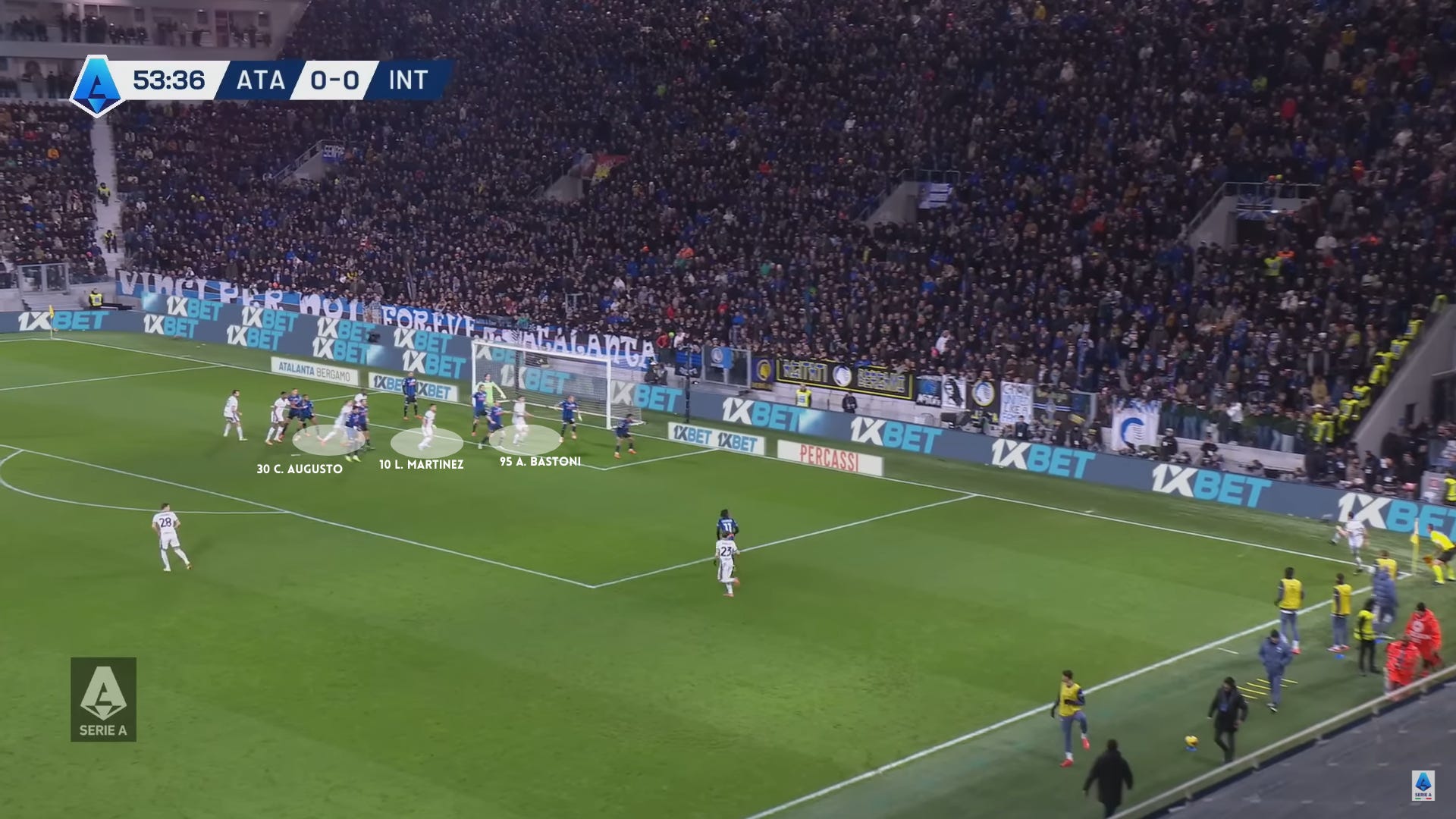Outswinging Corners: Internazionale's Powerhouse And Weapon
A tactical look into Internazionale outswinging corners' routine.
“Set pieces are a game within the game, it is a dead-ball situation and we decide the taker, we decide how many players to go in the box, we decide the space to attack, and we decide the timing. It’s completely different.” says Gianni Vio.
Previously, in January, I posted a large article about Inter’s intricate playing style in possession based on passing, as Nerazzurri are one of the few teams in Europe to rely on dribbles to create goal-scoring chances.
The Introduction was as follows:
In an era of coaches tweaking their philosophies and styles to provide quality moments in wide channels for the wingers to be in one-versus-one situations and stretch the width of the pitch, Inter and Inzaghi are defying the odds. Nerazzurri almost never dribbles to take on opponents. In contrast, their utmost weapon is swift passes to weave past the adversary. Not only that, but they score a lot of goals.
Inter Simone Inzaghi: How To Score Without Dribbling
In an era of coaches tweaking their philosophies and styles to provide quality moments in wide channels for the wingers to be in one-versus-one situations and stretch the width of the pitch, Inter and Inzaghi are defying the odds. Nerazzurri almost never dribbles to take on opponents. In contrast, their utmost weapon is swift passes to weave past the ad…
Inter are topping the league in terms of goals scored (73 goals); 14 of them came from set pieces. In other words, 19.17% of Inter goals are from set plays.
Behind Inter’s masterclass stands Ferruccio Cerasaro, who is the Nerazzurri’s set pieces coach and analyst.
Corners have been one of Internazionale’s strengths during the 2024-25 season. Nerazzurri banked 14 set pieces in Serie A, the team with the most goals in this regard. In fact, they put two goals home against Bayern Munich in the second leg of the quarter-final of the UEFA Champions League to secure a spot in the semi-final.
Against Barcelona, Denzel Dumfries capitalized on Inter’s outswinging corners to put his name twice on the scoresheet in the first leg against the Catalans. That hugely contributed to sending his team to the Allianz Arena, where the final of the 2024-25 Champions League will take place.
Nerazzuri leads the statistics considering the number of goals they scored per 100 corners played. They accumulated 5.26 goals per 100 corners this term.
Adding to that, they are at the top of the chart in terms of expected goals generated from set pieces with 0.42 xG per game, which means that they create high-quality chances from such play.
A big chunk of Inter’s corners are outswinging kicks. According to The Athletic, the majority of the deliveries target the front post and the central area in front of the six-yard box.
The general concept
Usually, Inter corners are played by Federico Dimarco and Hakan Çalhanoğlu.
Inside, Bastoni is deployed at the edge of the six-yard box with the rest behind around the penalty area.
As Çalhanoğlu readies himself to play the corner, Bastoni attacks the near-post zone, and the players behind attack the path of the ball in a diagonal shape.
Bastoni, targeting the near post zone, aims to disturb the opposition marking this area. His movement also vacates that space by dragging players with him should the ball land toward the near post. If not, players running diagonally behind play a crucial role in Inter's being dangerous in such play.
The telos behind Inter’s players splitting in a diagonal shape is to allow each one of them to attack the delivery from different heights as the ball travels on one hand. On the other hand, it enables the opportunity to flick the ball into the far post for the player in that zone.
Details
In the first leg of the semi-final against Barcelona, Inter scored from two corner kicks. Both were delivered in an outswinging way from Dimarco and Çalhanoğlu.
Here, Lautaro Martinez and Bastoni are at the edge of the six-yard box, trying to disrupt Barcelona’s players who mark that space. Behind, Thuram, Bisseck, and Acerbi prepare to split diagonally, with Dumfries coming from behind. Çalhanoğlu, Mkhitaryan, and Barella are deployed at the edge of the box in case Dimarco plays a short corner or to capitalize on a rebound. Not only that, but their positions serve the purpose of preventing Barcelona from counterattacking (counterpressing and winning the second balls).
De Jong on the left keeps tabs on Çalhanoğlu in case Dimarco plays a short kick. Barcelona has Raphinha protecting the near-post zone. Ferran Torres is zonal in the middle at the edge of the six-yard box, with Pau Cubarsí and Pedri man-marking Bastoni and Lautaro Martinez. Around the penalty box, Barcelona commits four players to deal with Inter’s three players. Lamine Yamal stays high to be ready for a counterattack.
As Dimarco delivers, Inter’s players at the edge of the six-yard box block off their markers. That vacates the space on the far post for Dumfries to come from behind and attack it. In the meantime, Bisseck, Acerbi, and Thuram split diagonally to frame the cross. Acerbi jumps and flicks the ball to Dumfries, who wonderfully fires the ball home.
Here, against Bayern Munich, Inter follows similar patterns.
Bastoni takes place near the front post. Bayern Munich has five zonal players at the edge of the six-yard, with Leon Goretzka covering the near-post zone. Michael Olise and Leroy Sané engage with Hakan Çalhanoğlu and Henrikh Mkhitaryan in case Dimarco plays a short corner.
In front of Bayern Munich’s zonal players, the Bavarian team commits two players, Konrad Laimer and Thomas Muller, against Pavard, Acerbi, Lautaro Martinez, and Marcus Thuram.
As Dimarco readies himself to take the corner, Pavard darts behind Laimer, and Acerbi behind Muller. Meanwhile, Marcus Thuram attacks the far post zone, and Lautaro Martinez, with a little nudge, creates separation with Joshua Kimmich to be able to take steps backward and head the ball. It hits Kimmich, and the former gobbles up the rebound.
Notice how Pavard, Acerbi, and Lautaro Martinez line up in a diagonal way to be able to hit the ball at different heights.
The same pattern replicated itself when Benjamin Pavard scored Inter second against Bayern Munich in the second leg of the quarter-final of the UEFA Champions League.
Bastoni disrupts Goretzka toward the near-post. Bayern Munich deploys four zonal players at the edge of the six-yard box and three cogs ahead, man-marking Thuram, Lautaro Martinez, and Pavard. Michael Olise occupies Acerbi around the penalty area.
As Çalhanoğlu pinpoints his intention to deliver the cross, Thuram dashes toward the far post. Acerbi runs onto the near-post zone, distracting Konrad Laimer. That resulted in Pavard sneaking behind the latter, moving into the six-yard box, and heading the ball home. Kimmich and Muller were unable to help Laimer as they were tasked with keeping tabs on Lautaro Martinez.
From the same side against Como, Carlos Augusto scored Inter’s opener.
Thuram attacked the far post, and Bastoni moved his body toward the far post, vacating the edge of the six-yard box for Lautaro Martinez to move into. Bisseck, Augusto, and Dumfries split in a diagonal manner, running on opposite sides to the ball. That allowed Inter players to hit the ball with momentum in the jump.
Lautaro and Bisseck's diagonal runs dragged Goldaniga and Dossena, and consequently freed the zone for Augusto to collect Çalhanoğlu’s cross. Adding to that, Inter’s attacking the path of the ball coming from behind gave them the edge to target it from the blind side of the marker, as the opponents cannot commit while at the same time keeping their eyes on the ball and Inter’s players.
Not only does Bastoni's near-post position disrupt the opponents who mark that zone, but it also serves Nerazzurri well when the corner is delivered at a medium range for a flick toward the far post.
Here against Fiorentina, players behind Bastoni are all man-marked. Moreover, La viola put more emphasis on controlling the near post-zone and Inter’s cogs at the edge of the six-yard box and around the penalty area. As a consequence, the back-post is left free. Çalhanoğlu plays the ball to Bastoni, who heads the ball across toward the far post. The delivery crosses past Acerbi, who gets rid of his marker. However, Augusto also teleported there, but his shot hit the post.
This example against Parma highlights the advantage of deploying the players in a diagonal shape. Lautaro Martinez, Bisseck, and De Vrij set themselves to attack the cross. Nerazzurri diagonal players run from Parma’s blind side as they cannot defend Inter players and put the ball in their sight at the same time.
As Çalhanoğlu prepares to whip the corner, Inter's diagonal cogs target the front post to frame the cross, taking advantage of their run to gain momentum to leap and head the outswinging corner. Meanwhile, Thuram moves toward the far post to capitalize on Bisseck’s flick and fire the ball home.
As aforementioned, the majority of Inter’s outswinging corners are delivered to the near post or the central area.
Here, Ederson and Retegui cover the front post area, and Ademola Lookman sticks with Nicolo Barella to avoid a short corner kick scenario. Zappacosta takes place at the far post, with Djimsti being zonal in front of the goalkeeper and Marten de Roon at the edge of the six-yard box. Around the penalty box, Atalanta commits three players to man-mark Acerbi, Dumfries, and Augusto.
Before the corner kick is delivered, Bastoni attacks the front post, dragging De Roon with him. As a result, Lautaro Martinez darts into the space vacated by Bastoni. Djimsiti leaves his spot to prevent Lautaro from heading the ball.
In the meantime, Augusto gets rid of Kolašinac to exploit the evacuated area and fire the ball in the net.
Takeaways
To make your way through, or to keep climbing the ladder, and not only achieve the pinnacle, but to remain at the climax in modern football, you need to maximize on every aspect of the game.
Set plays are one of them. Ask Mikel Arteta, and what does Nicolas Jover offer them? Take a look at Aston Villa with Austin MacPhee, and ask what happened to Tottenham after Gianni Vio left them.
Ferruccio Cerasaro does the work behind the scenes. Two goals in the quarter-final of the Champions League and two others in the semi-final had a big part in Inter being in the final of the competition. It’s like Inter had an extra striker alongside Lautaro Martinez and Marcus Thuram.
Finally, as Gianni Vio titled his UEFA Pro license thesis: “Set Pieces: the 15-goal striker”.
If you’re enjoying what we are producing—whether it’s an analysis, scouting, or opinion—Please subscribe, leave a comment, and drop a like. It helps us know that people out there value the work, and it boosts us on the Substack algorithms.
“Sharing knowledge is not about giving people something, or getting something from them. That is only valid for information sharing. Sharing knowledge occurs when people are genuinely interested in helping one another develop new capacities for action; it is about creating learning processes.”~Peter Senge

